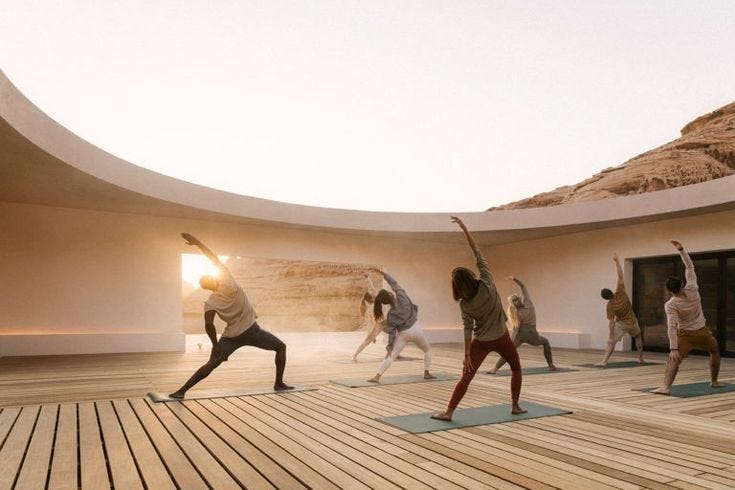Considering that June 14th was Global Wellness Day, June 21st was International Yoga Day and that I’ve been seeing too many retreats online, I thought it would be good to touch up on this industry and topic for the first post of this newsletter. I’ve noticed part of the tourism industry is changing and what we, as consumers, look for in our stays is not the same anymore; it now has to either align with our lifestyle or give us a break from it.
Wellness tourism is estimated to be a $1.4 trillion industry by 2028 - yes, read that again - the fact that just last year was a 651 billion dollar industry and this year we’ve seen plenty of spaces open or adapt to wellness is outstanding.
At first, I thought my algorithm had switched and was showing me many different options for retreats, then I started to notice various hotels offering wellness solutions and realised there’s a fundamental shift in how consumers approach travel, switching from traditional holiday concepts to preferring stays that prioritise mental, physical and emotional wellbeing. It certainly started with consumers going on retreats, valuing their sleep, to an escape from burnout, to now, as consumer awareness for healthy lifestyles improves, having to integrate with it. Today’s wellness travelers aren’t just seeking the usual temporary escape, they’re looking for transformative experiences that enhance their overall quality of life and it’s influencing their travel planning.
Therefore, wellness hotels are expanding globally and expanding their offerings to include well-designed fitness facilities, healthy dining options, meditation spaces, and even biohacking amenities. It is so sought out that wellness has become a fundamental design principle rather than an add-on service; 57% of travellers now prioritise wellness on a holiday. Others, a new category, have emerged with wellness as their core purpose, mostly created by companies that already have roots in the fitness and wellness industries and are simply building to tap that space in the market that their customers are already searching for.
Equinox, the fitness, wellness, and spa brand, opened its hotel in NYC with a focus on wellness in recent years and is now working on its second location in Nashville, with plans to expand to other markets in the coming years, focusing on fitness, wellness, and sleep improvement.
Health-focused resorts like Austrian Mayrlife Altausse, which brands itself as a medical health resort focused on optimising living and longevity to help restore gut health, and that includes various programmes for various metabolic-related conditions.
The MENA region has been heavily investing in the industry in recent years. I’m sure most of us have heard or seen photos of new hotels and resorts like Habitas AlUla in Saudi Arabia, Zulal Wellness Resort in Qatar, or like this surf therapy retreat in Morocco.
Wellness tourism’s target customers are mostly high net worth individuals or at least have a higher budget and income to afford these luxurious treatments, IV drips, and specific diets. In correlation to this, the CEO of the Saudi tourism investment company mentioned, “International wellness tourists spend, on average, 35 per cent more than traditional leisure travellers. This is a market segment that we cannot afford to ignore as we aim to welcome over 150 million visitors by 2030.”
Some of the trends we will be seeing more of are astro adventures as celestial retreats, the usual spa breaks and holistic wellness retreats, women’s health-focused treatments while on holidays, sleep improvement-focused stays, and we’ll definitely see more others popping up.
Let’s read each other next week on another topic and continue analysing our consumption behaviours.






